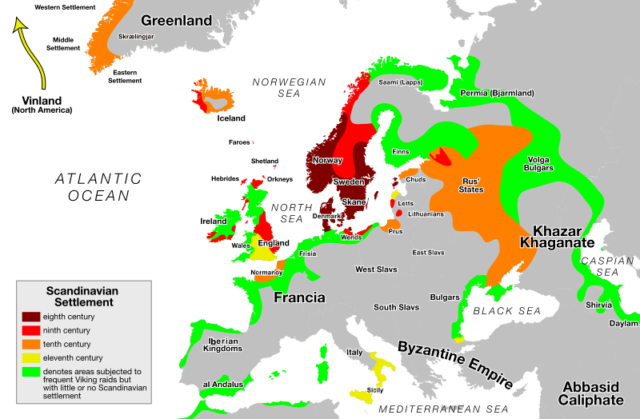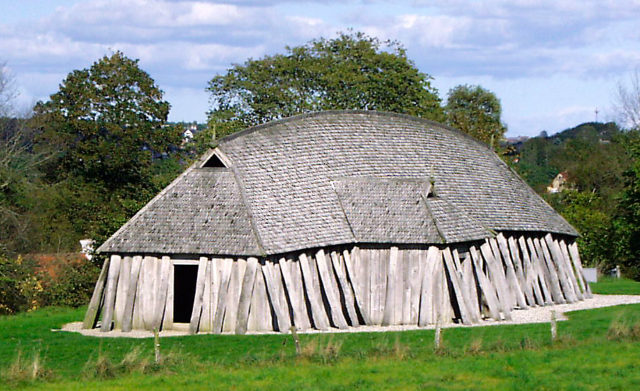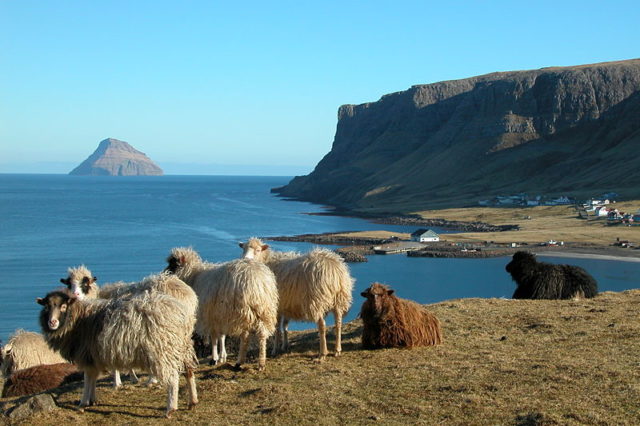From the 8th to the 11th century, there was an expansion of Viking influence from Denmark, Norway, and Sweden into eastern and western Europe.
Travel by sea was the easiest way for these Scandinavian people to explore. It was in the 8th century that shipbuilding expanded, which in turn started the raids that marked the beginning of the Viking Age.

There are a few theories as to why all of a sudden it seemed that the Vikings were exploring, invading, and colonizing new areas. At the time of this expansion, the British Isles were in disarray, as they were divided into small kingdoms and were nearly constantly at war with one another. They were easy prey for anyone who could get there. The Franks had fortified and would defend their coastal towns, so the cost was too high to expand there. The Franks were also already pushing into the southern end of Scandinavia and attacking Viking villages so that the people could have been pushed out due to this.

Another theory is that there was a population boom and there was not enough arable land around, so these new young adults had been looking for places to call their own. Trade routes were expanding and the wealth now moved further into Europe, enticing the Vikings into Western Europe and beyond. Also, this time of warm temperatures was a good time to move, as the Little Ice Age didn’t start till about 1250. No matter the reason, the population of the Vikings moved and grew as they raided, explored, and eventually colonized new areas.
Wherever they settled, the Vikings used the same settlement and farming methods as they did in their home countries. There is a good example of this at Kvivik, on the Island of Streymoy. There, an old Viking farm had a longhouse made from wood, stone, and earth; it was about 20 meters long and five meters wide. There was a building alongside the longhouse that would have been used as a cattle barn, with stalls and a drainage trench down the center.
A typical farm settlement was a cluster of buildings surrounded by fences; outside the fences, the land was cultivated. The Vikings built farmhouses at the top of slopes and near running fresh water; they preferred running water over well water. The farmhouse was on the high ground so that visitors could be seen approaching and if needed, warnings given to other farmers nearby. Other farming settlements are found on the Faroe Islands and existed for many generations. Some farmsteads on Faroe today are on top of the old remains of the original settlements. At this place, you can see “farm mounds.”

Traditional Scandinavian farming included the rearing of cattle, which were raised for dairy products that could be eaten fresh or stored for winter. The cattle from the Viking age were actually smaller than today’s animals, being only about 120 cm high. Sheep were also farmed and kept for their milk, wool, and meat. Neutered Sheep (wethers) could graze where they wished, but the ewes were penned. Rounding up sheep was a community effort, and they were able to sort out the possession by using special sorting pens. The sheep were also shorter in height. Horses were bred for both transportation and meat, which was a common part of Viking farmers’ diet.
The crops that the Vikings favored were grains; the three most predominantly raised were barley, rye, and oats. Wheat was grown as a luxury item and only in the southern areas. If the climate and soil were right, they also grew cabbage, beans, onions, and peas. Flax was grown as a utility crop for linen production. Large fields were worked by oxen pulling an arðr; the arðr cut grooves or channels into the soil, unlike the plow that turns the soil over. Smaller areas were turned over with hand tools. Vikings used manure on their fields to enable growing crops that were planted year after year. Crop rotation wasn’t used until later. They used sickles to harvest the grain, and once it was dry, they threshed it. They used the grain to make ale, porridge, and flour for bread. For heating, the Vikings would burn peat and wood; any iron smelting done in the community used wood in great quantities, About Education reported.

Families were self-sufficient, but they would have also traded with others who still explored the coastlines. In the digs of old settlements, archaeologists have found numerous objects that include locally made items and things from other European areas. A community of farms would be led by a chieftain-like back in their Scandinavian homelands.
Viking settlements are found all over the world – in Europe, the British Isles, North America, France, Canada, and Sicily. Today, some of the names of towns and villages in Britain still carry their Viking names, for example, Derby, Whitby, and Grimsby. The end of these words (by) means farm or homestead in Old Norse.
